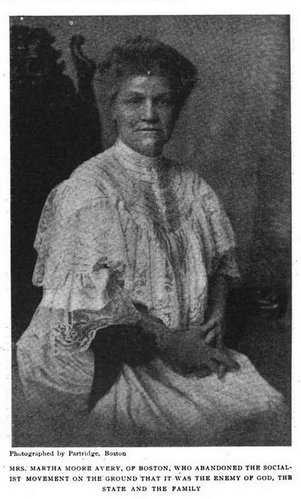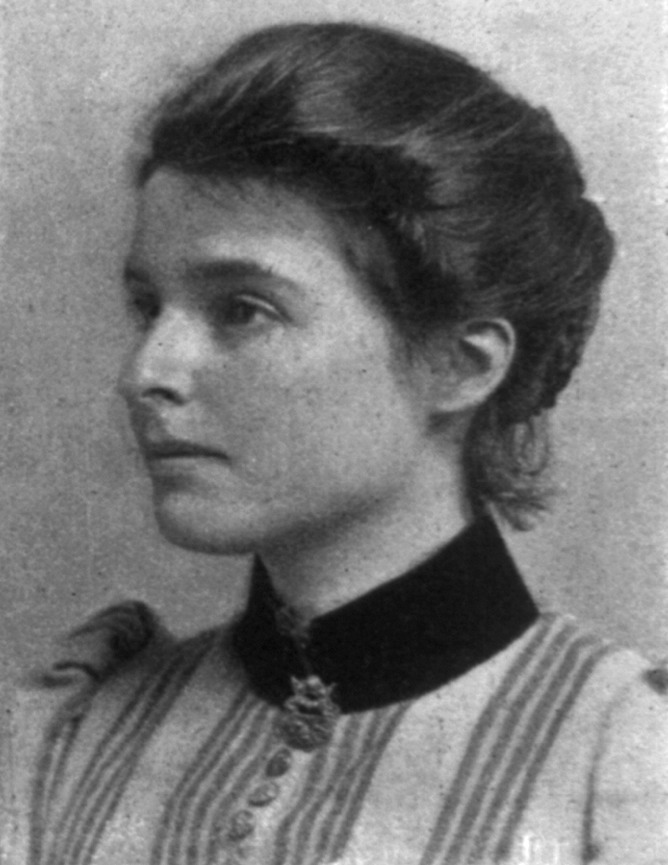|
Martha Gallison Moore Avery
Martha Gallison Moore-Avery (April 6, 1851 – August 8, 1929) was an American socialist who later converted to Catholicism and became an anti-Socialism activist. After her conversion, she became the founder of the Catholic labor organization Common Cause Society and of the Catholic Truth Guild, which became the most extensive lay apostolate of the Catholic Church in America. Early years Avery was born in Steuben, Maine, in 1851, one of eight children of Albion King Paris Moore and Katherine Leighton Moore. After the death of her mother when she was 13, she moved to live with her grandfather, Samuel Moore, who was a member of the Maine Senate. Later, in Ellsworth, Maine, she started a millinery business and became actively involved in religious life, joining the local Unitarian church. In 1880, she married another member of her church, Millard Fillmore Avery, and shortly later moved to Boston, Massachusetts. Boston and socialism Boston exposed her to a much wider range of ... [...More Info...] [...Related Items...] OR: [Wikipedia] [Google] [Baidu] |
Christian Socialist
Christian socialism is a religious and political philosophy that blends Christianity and socialism, endorsing left-wing politics and socialist economics on the basis of the Bible and the teachings of Jesus. Many Christian socialists believe capitalism to be idolatrous and rooted in the sin of greed. Christian socialists identify the cause of social inequality to be the greed that they associate with capitalism. Christian socialism became a major movement in the United Kingdom beginning in the 19th century. The Christian Socialist Movement, known as Christians on the Left since 2013, is one formal group, as well as a faction of the Labour Party. According to the Encyclopædia Britannica, socialism is a "social and economic doctrine that calls for public rather than private ownership or control of property and natural resources. According to the socialist view, individuals do not live or work in isolation but live in cooperation with one another. Furthermore, everything that peopl ... [...More Info...] [...Related Items...] OR: [Wikipedia] [Google] [Baidu] |
Social Justice
Social justice is justice in terms of the distribution of wealth, opportunities, and privileges within a society. In Western and Asian cultures, the concept of social justice has often referred to the process of ensuring that individuals fulfill their societal roles and receive their due from society. In the current movements for social justice, the emphasis has been on the breaking of barriers for social mobility, the creation of safety nets, and economic justice. Social justice assigns rights and duties in the institutions of society, which enables people to receive the basic benefits and burdens of cooperation. The relevant institutions often include taxation, social insurance, public health, public school, public services, labor law and regulation of markets, to ensure distribution of wealth, and equal opportunity. Interpretations that relate justice to a reciprocal relationship to society are mediated by differences in cultural traditions, some of which emphasize t ... [...More Info...] [...Related Items...] OR: [Wikipedia] [Google] [Baidu] |
Collective Bargaining
Collective bargaining is a process of negotiation between employers and a group of employees aimed at agreements to regulate working salaries, working conditions, benefits, and other aspects of workers' compensation and rights for workers. The interests of the employees are commonly presented by representatives of a trade union to which the employees belong. The collective agreements reached by these negotiations usually set out wage scales, working hours, training, health and safety, overtime, grievance mechanisms, and rights to participate in workplace or company affairs. The union may negotiate with a single employer (who is typically representing a company's shareholders) or may negotiate with a group of businesses, depending on the country, to reach an industry-wide agreement. A collective agreement functions as a labour contract between an employer and one or more unions. Collective bargaining consists of the process of negotiation between representatives of a union and em ... [...More Info...] [...Related Items...] OR: [Wikipedia] [Google] [Baidu] |
Strike Action
Strike action, also called labor strike, labour strike, or simply strike, is a work stoppage caused by the mass refusal of employees to Labor (economics), work. A strike usually takes place in response to grievance (labour), employee grievances. Strikes became common during the Industrial Revolution, when Labour economics, mass labor became important in factories and mines. As striking became a more common practice, governments were often pushed to act (either by private business or by union workers). When government intervention occurred, it was rarely neutral or amicable. Early strikes were often deemed unlawful conspiracies or anti-competitive cartel action and many were subject to massive legal repression by state police, federal military power, and federal courts. Many Western nations legalized striking under certain conditions in the late 19th and early 20th centuries. Strikes are sometimes used to pressure governments to change policies. Occasionally, strikes destabilize ... [...More Info...] [...Related Items...] OR: [Wikipedia] [Google] [Baidu] |
Labor Union
A trade union (labor union in American English), often simply referred to as a union, is an organization of workers intent on "maintaining or improving the conditions of their employment", ch. I such as attaining better wages and benefits (such as holiday, health care, and retirement), improving working conditions, improving safety standards, establishing complaint procedures, developing rules governing status of employees (rules governing promotions, just-cause conditions for termination) and protecting the integrity of their trade through the increased bargaining power wielded by solidarity among workers. Trade unions typically fund their head office and legal team functions through regularly imposed fees called ''union dues''. The delegate staff of the trade union representation in the workforce are usually made up of workplace volunteers who are often appointed by members in democratic elections. The trade union, through an elected leadership and bargaining committee, b ... [...More Info...] [...Related Items...] OR: [Wikipedia] [Google] [Baidu] |
Organizing Model
The organizing model, as the term refers to trade unions (and sometimes other social-movement organizations), is a broad conception of how those organizations should recruit, operate, and advance the interests of their members, though the specific functions of the model are more detailed and are discussed at length below. It typically involves many full-time organizers, who work by building up confidence and strong networks and leaders within the workforce, and by confrontational campaigns involving large numbers of union members. The organizing model is strongly linked to social movement unionism and community unionism. The organizing model contributes to the discussion of how trade unions can reverse the trend of declining membership, which they are experiencing in most industrial nations, and how they can recapture some of the political power, which the labor movement has lost over the past century. The organizing model is frequently compared and contrasted with other methods of ... [...More Info...] [...Related Items...] OR: [Wikipedia] [Google] [Baidu] |
Rerum Novarum
''Rerum novarum'' (from its incipit, with the direct translation of the Latin meaning "of revolutionary change"), or ''Rights and Duties of Capital and Labor'', is an encyclical issued by Pope Leo XIII on 15 May 1891. It is an open letter, passed to all Catholic patriarchs, primates, archbishops and bishops, that addressed the condition of the working classes. It discusses the relationships and mutual duties between labor and capital, as well as government and its citizens. Of primary concern is the need for some amelioration of "the misery and wretchedness pressing so unjustly on the majority of the working class". It supports the labour rights, rights of labor to form labor unions, unions, rejects both socialism and Laissez-faire, unrestricted capitalism, while affirming the right to private property. ''Rerum Novarum'' is considered a foundational text of modern Catholic social teaching. Many of the positions in ''Rerum novarum'' are supplemented by later encyclicals, in part ... [...More Info...] [...Related Items...] OR: [Wikipedia] [Google] [Baidu] |
Pope Leo XIII
Pope Leo XIII ( it, Leone XIII; born Vincenzo Gioacchino Raffaele Luigi Pecci; 2 March 1810 – 20 July 1903) was the head of the Catholic Church from 20 February 1878 to his death in July 1903. Living until the age of 93, he was the second-oldest-serving pope, and the third-longest-lived pope in history, before Pope Benedict XVI as Pope emeritus, and had the List of popes by length of reign, fourth-longest reign of any, behind those of Saint Peter, St. Peter, Pius IX (his immediate predecessor) and John Paul II. He is well known for his intellectualism and his attempts to define the position of the Catholic Church with regard to modern thinking. In his famous 1891 Papal encyclical, encyclical ''Rerum novarum'', Pope Leo outlined the rights of workers to a fair wage, safe working conditions, and the formation of trade unions, while affirming the rights of property and free enterprise, opposing both socialism and laissez-faire capitalism. With that encyclical, he became popularly ... [...More Info...] [...Related Items...] OR: [Wikipedia] [Google] [Baidu] |
May Day
May Day is a European festival of ancient origins marking the beginning of summer, usually celebrated on 1 May, around halfway between the spring equinox and summer solstice. Festivities may also be held the night before, known as May Eve. Traditions often include gathering wildflowers and green branches, weaving floral garlands, crowning a May Queen (sometimes with a male companion), and setting up a Maypole, May Tree or May Bush, around which people dance. Bonfires are also part of the festival in some regions. Regional varieties and related traditions include Walpurgis Night in central and northern Europe, the Gaelic festival Beltane, the Welsh festival Calan Mai, and May devotions to the Blessed Virgin Mary. It has also been associated with the ancient Roman festival Floralia. In 1889, 1 May was chosen as the date for International Workers' Day by the Second International, to commemorate the Haymarket affair in Chicago and the struggle for an eight-hour working day. ... [...More Info...] [...Related Items...] OR: [Wikipedia] [Google] [Baidu] |
Catholic School
Catholic schools are pre-primary, primary and secondary educational institutions administered under the aegis or in association with the Catholic Church. , the Catholic Church operates the world's largest religious, non-governmental school system. In 2016, the church supported 43,800 secondary schools and 95,200 primary schools. The schools include religious education alongside secular subjects in their curriculum. Background Across Europe, North America, Australia and New Zealand, the main historical driver for the establishment of Catholic schools was Irish immigration. Historically, the establishment of Catholic schools in Europe encountered various struggles following the creation of the Church of England in the Elizabethan Religious settlements of 1558–63. Anti-Catholicism in this period encouraged Catholics to create modern Catholic education systems to preserve their traditions. The Relief Acts of 1782 and the Catholic Emancipation Act of 1829 later increased the pos ... [...More Info...] [...Related Items...] OR: [Wikipedia] [Google] [Baidu] |
Roman Catholicism
The Catholic Church, also known as the Roman Catholic Church, is the List of Christian denominations by number of members, largest Christian church, with 1.3 billion baptized Catholics Catholic Church by country, worldwide . It is among the world's oldest and largest international institutions, and has played a prominent role in the history and development of Western civilization.Gerald O'Collins, O'Collins, p. v (preface). The church consists of 24 Catholic particular churches and liturgical rites#Churches, ''sui iuris'' churches, including the Latin Church and 23 Eastern Catholic Churches, which comprise almost 3,500 dioceses and Eparchy, eparchies located List of Catholic dioceses (structured view), around the world. The pope, who is the bishop of Rome, is the Papal supremacy, chief pastor of the church. The bishopric of Rome, known as the Holy See, is the central governing authority of the church. The administrative body of the Holy See, the Roman Curia, has its pr ... [...More Info...] [...Related Items...] OR: [Wikipedia] [Google] [Baidu] |








_by_Antonio_Reyna_Manescau.jpg)

.jpg)